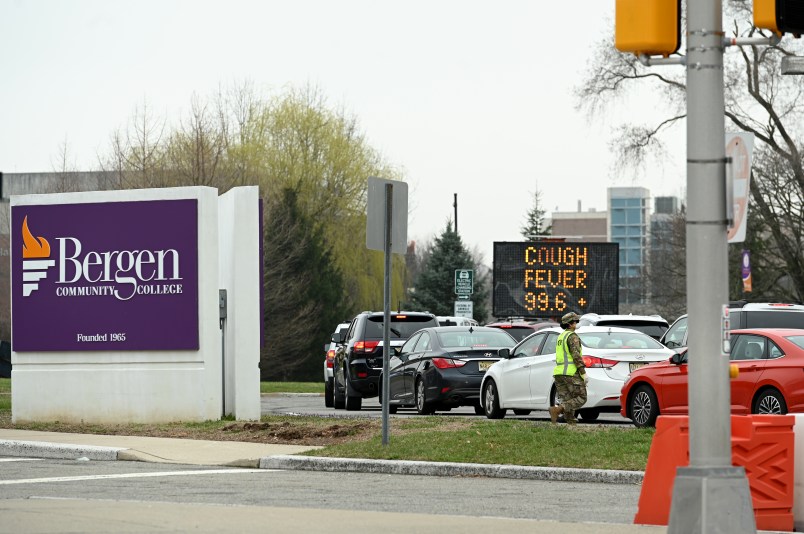New guidance from the Centers for Disease Control recommends against universities testing students, faculty and staff who are not displaying symptoms of COVID-19 and who have not knowingly interacted with an infected person upon their return to school.
It has some experts up in arms, and, public health professionals told TPM, provides yet one more example of the problems with the U.S.’s lack of a national testing strategy.
“In spite of numerous legitimate concerns about the safety of reopening and the fact that we know presymptomatic transmission is a major driver of spread, the CDC has gone ahead and recommended no testing for school reopening,” tweeted Dr. Angela Rasmussan, a virologist at Columbia University’s school of public health. “Unbelievable.”
“This recommendation from the CDC, coupled with the rationale given, beggars belief,” added Carl Bergstrom, a biology professor at the University of Washington, on Twitter. “This is the thinnest of absence-of-evidence arguments.”
The CDC’s advice is part of a slate of new guidelines for institutions of higher education released on Tuesday.
“Testing of all students, faculty and staff for COVID-19 before allowing campus entry (entry testing) has not been systematically studied,” the guidance said. “It is unknown if entry testing in IHEs provides any additional reduction in person-to-person transmission of the virus beyond what would be expected with implementation of other infection preventive measures (e.g., social distancing, cloth face covering, hand washing, enhanced cleaning and disinfection).”
The CDC’s aversion may be rooted in worry about a lack of sufficient testing equipment, experts told TPM.
“We don’t have nearly enough testing for there to be regular testing of all students and staff upon return to schools and universities,” Dr. Leana Wen, an emergency physician and visiting professor of health policy and management at George Washington University, told TPM.
“I suspect that may have something to do with this guidance, as you can’t just test everyone once — it needs to be done on a regular basis. This is yet another reason we need to urgently ramp up testing, and why we need a national strategy to get there,” she added.
Indeed, the CDC hints at the lack of supplies as a consideration schools should take while considering how broadly to test their populations, highlighting the possible “limited availability of dedicated resources and the logistics needed to conduct broad testing among students, faculty, and staff in IHE settings.”
Bergstrom, in a Twitter thread, maintains that the CDC should still advise colleges and universities to test everyone, pushing the institutions to scale up their testing apparatuses before the new school year.
But if you don’t even recommend testing, you are not putting pressure on universities to think spend the next two months figuring out how to scale up testing capacity—something which is obviously a desperate need in most parts of the country.
— Carl T. Bergstrom (@CT_Bergstrom) July 2, 2020
Dr. Susan Hassig, an epidemiologist at Tulane University’s school of public health and tropical medicine, said that the CDC isn’t putting testing the asymptomatic group on the “to do list” of measures that will definitely tamp down the spread.
“Theoretically, if everyone was masked and distant at all times (highly unlikely, by the way) entry infection status would not be a major driver of infection,” she told TPM. “It is far more likely that off-campus activity once classes begin, particularly of students, along with the underlying level of infection in the campus location, will drive infection experience.”
According to a recent Inside Higher Ed Report, no state is currently requiring colleges, hundreds of which are reopening this fall, to test everybody on campus.
One factor in that decision is cost: private universities are already coping with massive COVID-caused losses from the spring, and public universities would be to some degree relying on the states, many of which are strapped for cash and resources as it is.
Additionally, there is some debate about the usefulness of testing asymptomatic people in the first place.
According to a May study by researchers at Johns Hopkins University, tests frequently find that those tested do not have the disease even if they’re just days away from exhibiting symptoms.
That test result, some worry, could encourage people to behave recklessly even though they could actually be sick.
Justin Lessler, an associate professor at the Johns Hopkins Bloomberg School of Public Health and one of the study’s authors, told Inside Higher Ed that the tests are still worth doing, since they’ll identify some people who need to quarantine themselves. Additionally, he said, it was never the case that one test would suffice — people need to be tested frequently to control the disease.
Students and faculty need to be informed of how the tests work, he argued, so they understand that a negative result “isn’t carte blanche to go out and behave as if you’re uninfected.”



